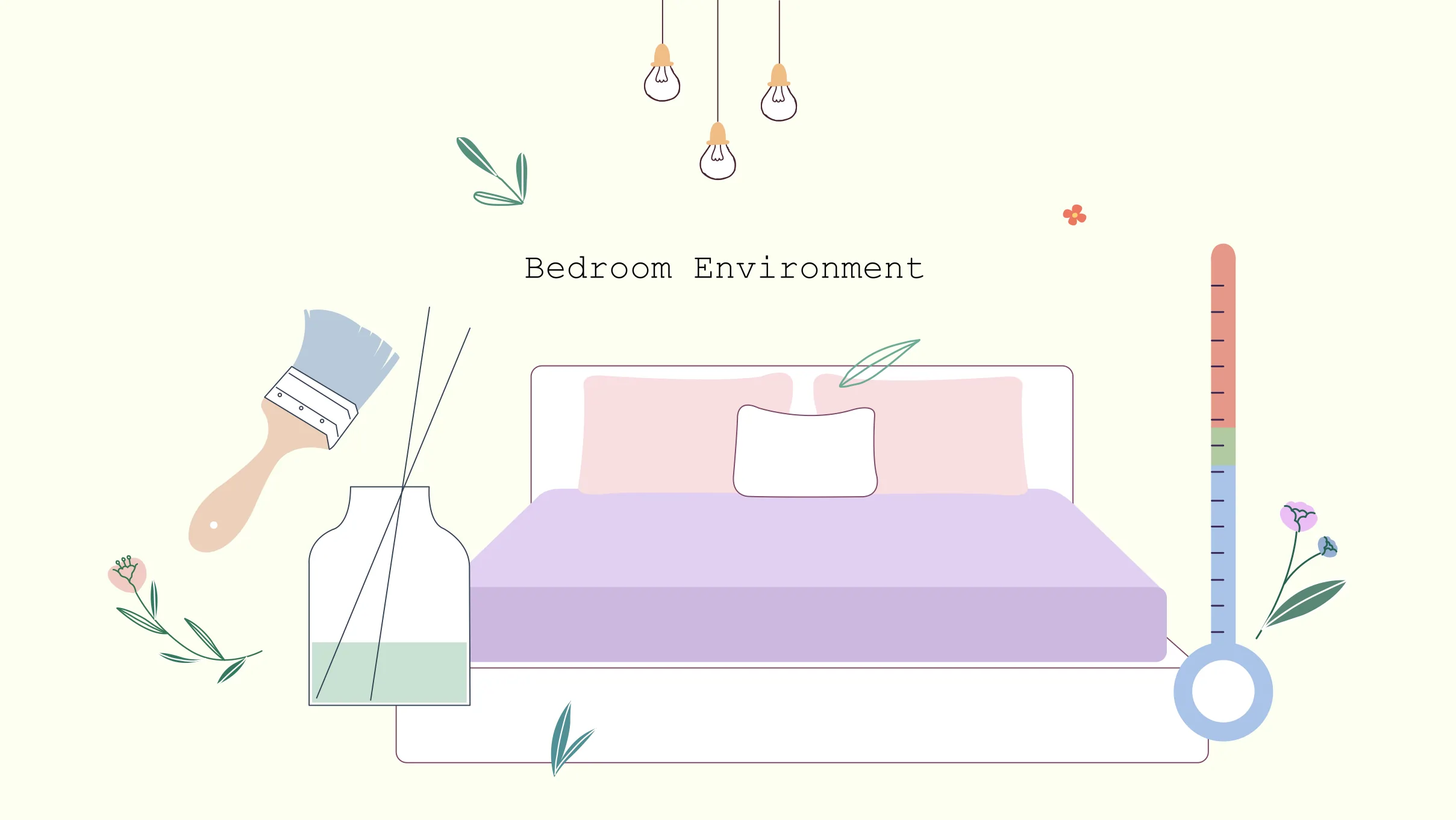Bedroom Environment: Important Elements for Better Sleep
Written by


Your bedroom is a sanctuary of comfort, rest, and relaxation. It should be your haven where you can unwind from a stressful day. But imagine coming home to a cluttered room with unbearable temperature, bright lights, and uncomfortable bedding. It’ll throw your sleepiness right out of the window!
Creating a comfortable bedroom environment is essential if you ever want to relax. Research has proved that the environment has a quantifiable effect on your sleep. Remember, sleep is a sensory experience that is easily broken by disturbances. So, if you wish to have a long sleep, it is best to optimize your sleep environment.
Read on to learn the important elements of a relaxing bedroom and different ways to make your bedroom better for sleep!
Important Elements of a Relaxing Bedroom
While preparing your relaxing bedroom environment, you have to keep the following elements in mind:
Temperature
Body temperatures tend to differ for individuals; some run cold while others are hot. However, every healthy adult experiences a temperature drop at night. This occurs because of the lower core temperature, which makes you sleepy. Whether you have a thick blanket or only a thin sheet, the ideal temperature of your room is 65 degrees Fahrenheit (18.3 degrees Celsius).
Noise
It is a no-brainer – a quieter room helps you sleep better. However, loud sounds lead to unnatural wakefulness causing severe sleep fragmentation. This, in turn, can negatively impact your physical and mental well-being.
To achieve the best sleep, try to keep the noises to a minimum. Any soothing noise that can lull you to sleep, like the whir of a fan or white noise machine, can be added to the bedroom.
Light
Circadian rhythm, or the sleep-wake cycle, is heavily influenced by sunlight (natural light) and darkness. Artificial light can also induce cortisol, the hormone responsible for keeping you awake.
Research has shown the effect of light on sleep and suggests that exposure to 10 lux or higher light can lead to nocturnal awakenings. So, keep your room light at a minimum and avoid blue light before sleeping.
Mattress and Bedding
Besides these factors, your bedding should be comfortable and contour snuggly around your body. Changing your mattress every few years is also recommended, as research suggests that newer ones give better sleep.
While selecting your mattress, you should always prioritize your personal preferences, like your preferred position, body weight, and surface choice.
How can you customize your bedroom to get the best sleep environment for babies and adults? Jump to the next section!
9 Ways to Make Your Bedroom Better for Sleep
Converting your room into a perfect sleeping place is easier than it seems. Here’s a sleep environment checklist to incorporate into your room ASAP!
1. Clean Out All the Clutter
Your room isn’t a storage unit. If you wish to associate sleep with the room, it is best to clear out the clutter in your room. Any distracting object that might hinder your sleep must go to a different room. For example, your work desk and computer need to be shifted, and the TV ditched.
With so many activities in your room, your brain will find it hard to relax and look for distractions. Your work desk will induce anxiety about the pending, while your TV will force you to think about different shows.
2. Ditch All Electronics
Just like computers and TV, it is best to keep all other electronic devices like phones, tablets, gaming consoles, e-readers, and laptops out of the way. They’re highly engaging devices that will suck your time and won’t let you sleep on time.
If you have a digital alarm clock, position it away from your eyesight. Not only is the light from it distracting, but it also induces anxiety about the time they might be losing by not sleeping. This anxiety transforms into a hyperactive brain that refuses to calm and shut down.
3. Keep Your Room Dark
We’ve already discussed how artificial lights imitate natural light and act as a barrier to good sleep. The best way to counter this is to eliminate all lights in the room. This implies the removal of all lights like table lamps, night lights, or any other sources. Get blackout blinds or thick curtains for external lights coming from the window.
If your phone is necessary to keep around you, flip it upside down. By doing so, you’ll be able to remove the light from screen notifications, calls, or messages. In addition, you can remove notifications from apps you do not need.
4. Keep Your Room Quiet
Noises are the most common sleep stealer that disrupts your bedroom environment. Be it sounds inside the room or outside, they’re all equally bad for your sleep. In reality, it is not noise, but the sudden and inconsistent noises that prevent sleep or rouse you.
So, if noises outside disrupt your sleep, get yourself a white sound machine. It’ll produce soothing sounds that will drown out noises and lull you into a comfortable sleep.
5. Keep Your Room Cool
Even if you have a body that generally runs hot, it is bound to go cold during the night due to the lower core temperature. Hence, keeping the room temperature between 60-67 degrees is suggested.
Sleeping naked is also an excellent way to promote a night of good sleep. By eliminating nightgowns and pyjamas, you’ll allow the body to cool faster and fall into slumber.
6. Use Aromatherapy
Research suggests that inducing aroma and pleasant scents into the room can help promote sleep. Aromatherapy creates an atmosphere by introducing scents in the room, which is relaxing and soothing and helps you sleep well.
It is also an excellent way to program your brain into associating a specific smell as a cue to sleep. With regular use, this cue will automatically develop and help you sleep easier.
7. Paint Your Room
A British study concluded that the room’s colour also affects your sleep. The study that included 2000 British houses showcased that the colours blue, yellow, and green gave the sleepers the most sleep. Blue granted most with 7 hours 52 minutes, yellow at 7 hours 40 minutes, and green at 7 hours 36 minutes.
These three colours are often associated with relaxation and serenity and help you sleep peacefully. On the other hand, colours like grey, brown, and purple are chaotic and ruin your sleep. Sleep associated with these colours is – grey with 6 hours 12 minutes, 6 hours 5 minutes for brown, and 5 hours 56 minutes for purple.
According to this study, purple is associated with creativity and an artistic mind, while brown and grey are related to depression and dreariness.
8. Use the Right Bedding
To maintain a healthy sleep environment for newborns, teens, and adults, it is best to use the right bedding and fabric. Certain fabrics retain “moisture-wicking” properties, implying that they can easily absorb moisture and give you a comfortable sleep.
Some of these fabrics include wool, cotton, linen, and bamboo. On the other hand, synthetic fabrics like polyester and satin trap moisture and make the bed warmer. The fabric does not necessarily need a high thread count, but it should feel nice against your skin.
9. Get Comfortable Mattresses
In the entire sleep equation, the mattress plays an integral role. The Better Sleep Council suggests that mattresses have a life span of 7 years and should be changed after the period to ensure maximum comfort.
While people tend to keep their mattresses for 10 years or more, you should get them replaced as soon as it starts to cause pain or shows signs of deprivation. For a long-term mattress, you should use latex and memory foam because beds with springs wear out faster.
Conclusion
While it may not look like much, several small things in your room can hinder your sleep. By making specific changes in your sleep environment, you can achieve good slumber hygiene and maximize your comfortableness. Just maintain the 4 elements at their viable level and execute the 9 ways to make your bedroom more comfortable – perfect sleep after a long day!
FAQs
What is the importance of a bedroom?
A bedroom is a spot where one can unwind, escape, and, most importantly, sleep after having a day full of work, fatigue or stress.
How should I set up my bedroom to sleep?
Invest in a quality mattress, add lighting in layers, declutter to decompress, take note of the colours, pay attention to linens, and keep the arrangement and size in mind to set up everything.
How to change your bedroom environment?
Reduce the clutter, and change the room’s colours, temperature, smell and feel by organizing things differently and shopping for new covers and decorative pieces.
How to create a dog-friendly environment in the bedroom?
Keep the room clean; add attractive and chewable toys, food and grooming equipment for your dog, and a comfortable bed for it to rest in.
people like this article
Written by








